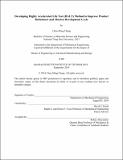| dc.contributor.advisor | David E. Hardt. | en_US |
| dc.contributor.author | Chang, Chun-Ming, M. Eng. Massachusetts Institute of Technology | en_US |
| dc.contributor.other | Massachusetts Institute of Technology. Department of Mechanical Engineering. | en_US |
| dc.date.accessioned | 2017-01-30T18:50:39Z | |
| dc.date.available | 2017-01-30T18:50:39Z | |
| dc.date.copyright | 2016 | en_US |
| dc.date.issued | 2016 | en_US |
| dc.identifier.uri | http://hdl.handle.net/1721.1/106687 | |
| dc.description | Thesis: M. Eng. in Advanced Manufacturing and Design, Massachusetts Institute of Technology, Department of Mechanical Engineering, 2016. | en_US |
| dc.description | This electronic version was submitted by the student author. The certified thesis is available in the Institute Archives and Special Collections. | en_US |
| dc.description | Cataloged from student-submitted PDF version of thesis. | en_US |
| dc.description | Includes bibliographical references (pages 80-81). | en_US |
| dc.description.abstract | Highly Accelerated Life Testing (HALT) is often used to identify the latent defects for the printed circuit boards (PCBs) during the early stage of the product development process. The inconsistency in executing HALT may not reveal the maximum amount of design weaknesses or intermittent failures, which would eventually lead to the premature product failure in the field and incur additional warranty expenses. The scope of this project has focused on establishing the standardized operating procedure (SOP) for Highly Accelerated Life Testing (HALT) using the DMAIC methodology for the electronic components such as printed circuit boards (PCBs) to help identify these latent issues in advance and increase product robustness. In addition to applying statistical tools to optimize several key process parameters such as soaking time and ramp rate, the related failure analysis and corrective actions were also demonstrated in this thesis. In summary, three major results are shown: first, following the DMAIC guideline, the standard operating procedure (SOP) of HALT was established and applicable to all types of printed circuit boards. Secondly, it was shown that the top three failure modes identified in HALT were almost identical to that of the field returns'. Last but not least, the relationship between the operating margins and the warranty replacement rate was also established. Although more data points are required to further consolidate the model, the current result has indicated that there is a declining trend of the warranty replacement rate for every increment of the temperature operating margins. Such mathematical relationship was then used in the economic model to justify the business benefit of HALT. | en_US |
| dc.description.statementofresponsibility | by Chun-Ming Chang. | en_US |
| dc.format.extent | 81 pages | en_US |
| dc.language.iso | eng | en_US |
| dc.publisher | Massachusetts Institute of Technology | en_US |
| dc.rights | MIT theses are protected by copyright. They may be viewed, downloaded, or printed from this source but further reproduction or distribution in any format is prohibited without written permission. | en_US |
| dc.rights.uri | http://dspace.mit.edu/handle/1721.1/7582 | en_US |
| dc.subject | Mechanical Engineering. | en_US |
| dc.title | Developing Highly Accelerated Life Test (HALT) method to improve product robustness and shorten development cycle | en_US |
| dc.type | Thesis | en_US |
| dc.description.degree | M. Eng. in Advanced Manufacturing and Design | en_US |
| dc.contributor.department | Massachusetts Institute of Technology. Department of Mechanical Engineering | |
| dc.identifier.oclc | 969774259 | en_US |
